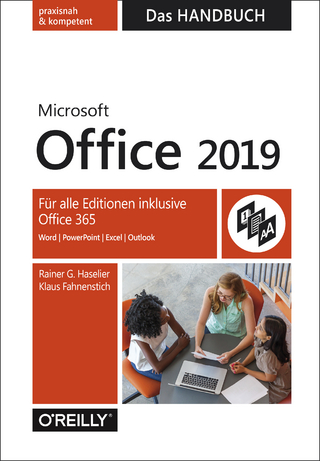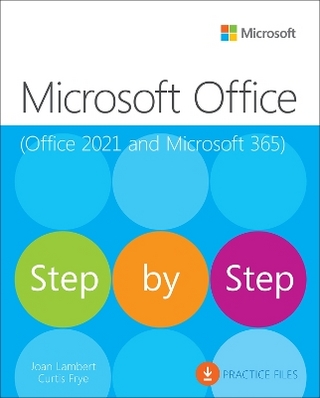
Microsoft Office 2003 for Healthcare
Que Corporation,U.S. (Verlag)
978-0-7897-3211-8 (ISBN)
- Titel ist leider vergriffen;
keine Neuauflage - Artikel merken
Healthcare offices are busy places and healthcare professionals are busy people. Between constantly ringing phones and patients coming in and out, who has time to learn about Microsoft Office? Our helpful, step-by-step guide, Microsoft Office 2003 for Healthcare, is designed to be easy-to-read and single-task oriented for quick reference. Explore how you can use Microsoft Office 2003 to create patient charts, billing procedures and more. Also included is a troubleshooting guide to help you quickly solve problem, so you can maximize the time you spend delivering healthcare and minimize the time you have to spend on administrative duties.
Microsoft Office 2003 for HealthcareAbout the Authors Dr. Ahmad Hashem is a global healthcare productivity manager for Microsoft's Healthcare and Life Sciences Industry Solutions Group. He is responsible for defining and guiding implementation of Microsoft's worldwide strategy for empowering information workers across the Healthcare and Life Sciences industries. Before joining Microsoft in 2000, Ahmad was CIO at a healthcare e-learning company in Santa Monica, California, director and acting COO at Medical Archival Systems in Pittsburgh, and a National Library of Medicine fellow in medical informatics at the University of Pittsburgh Medical Center. In addition to his doctorate in medicine from the University of Damascus, Ahmad holds a Bachelor of Science degree in computer science from the University of Massachusetts and a doctorate in medical informatics, Cognitive Program, from the University of Pittsburgh. Ahmad can be reached at ahmad@hashem.net. Steve Johnson has written more than 20 books on a variety of computer software, including Microsoft Office XP, Microsoft Windows XP, Macromedia Director MX and Macromedia Fireworks, and Web publishing. In 1991, after working for Apple Computer and Microsoft, Steve founded Perspection, Inc., which writes and produces software training. When he is not staying up late writing, he enjoys playing golf, gardening, and spending time with his wife, Holly, and three children, JP, Brett, and Hannah. When time permits, he likes to travel to such places as New Hampshire in October, and Hawaii. Steve and his family live in Pleasanton, California, but can also be found visiting family all over the western United States. © Copyright Pearson Education. All rights reserved.
Foreword.
Introduction.
1. Getting Started with Office.
Starting an Office Program.
Using Task Panes.
Choosing Menu and Dialog Box Options.
Working with Toolbars.
Creating a New File.
Saving a File.
Saving a File with Different Formats.
Opening an Existing File.
Finding a File or Text in a File.
Arranging Windows.
Getting Help in an Office Program.
Getting Help from the Office Assistant.
Closing a File.
Getting Office Updates on the Web.
Repairing and Recovering Office Programs.
Quitting an Office Program.
2. Using Shared Office Tools.
Editing Text.
Working with the Clipboard.
Finding and Replacing Text.
Using Multiple Languages.
Correcting Text Automatically.
Inserting Information the Smart Way.
Making Corrections.
Inserting Comments.
Using Track Changes.
Comparing and Merging Documents.
Inserting Research Material.
Controlling Programs with Your Voice.
Executing Voice Commands.
Dictating Text.
Recognizing Handwriting.
Automating Your Work with Macros.
Modifying a Macro.
3. Adding Art to Office Documents.
Selecting, Moving, and Resizing Objects.
Drawing and Enhancing Objects.
Adding WordArt.
Inserting Clip Art.
Inserting a Picture.
Inserting a Picture from a Scanner or Camera.
Modifying Pictures.
Creating an Organization Chart.
Creating a Diagram.
Creating a Graph Chart.
Modifying a Graph Chart.
Managing Pictures.
Sharing Pictures Using E-Mail.
4. Creating a Document with Word.
Viewing the Word Window.
Creating a Document.
Changing Document Views.
Reading a Document.
Working with Multiple Documents.
Moving Around in a Document.
Setting Up the Page.
Setting Up the Page Margins.
Creating an Outline.
Selecting Text.
Inserting Symbols and AutoText.
Checking Spelling and Grammar.
Finding the Right Words.
Previewing a Document.
Printing a Document.
5. Formatting a Document with Word.
Formatting Text for Emphasis.
Formatting Text with Special Effects.
Revealing Formatting.
Finding and Replacing Formatting.
Changing Paragraph Alignment.
Changing Line Spacing.
Displaying Rulers.
Setting Paragraph Tabs.
Setting Paragraph Indents.
Changing Character Spacing.
Applying a Style.
Creating and Modifying Styles.
Creating Bulleted and Numbered Lists.
Inserting New Pages and Sections.
Adding Headers and Footers.
Inserting Page Numbers and the Date and Time.
Working with Templates.
Hiding Text.
6. Enhancing a Document with Word.
Adding Desktop Publishing Effects.
Arranging Text in Columns.
Creating a Table.
Entering Text in a Table.
Modifying a Table.
Adjusting Table Cells.
Formatting a Table.
Creating a Form Letter.
Creating Labels.
Addressing Envelopes and Labels.
Inserting a Table of Contents.
Creating Multiple Document Versions.
Modifying the Document Summary.
Protecting a Document.
7. Creating a Worksheet with Excel.
Viewing the Excel Window.
Selecting Cells.
Moving Around Cells.
Entering Text and Numbers.
Making Label Entries.
Editing Cell Contents.
Clearing Cell Contents.
Inserting and Deleting Cells.
Selecting a Column or Row.
Inserting and Deleting Columns or Rows.
Hiding and Unhiding a Column or Row.
Adjusting Column Width and Row Height.
Selecting and Naming a Worksheet.
Inserting and Deleting a Worksheet.
Moving and Copying a Worksheet.
Hiding and Unhiding Worksheets and Workbooks.
Splitting a Worksheet in Panes.
Freezing Panes.
8. Building a Worksheet with Excel.
Creating a Simple Formula.
Editing and Copying a Formula.
Naming a Range.
Simplifying a Formula with Ranges.
Understanding Cell Referencing.
Using Absolute Cell References.
Performing Calculations Using Functions.
Calculating Results.
Correcting Calculation Errors.
Creating a Chart.
Selecting and Editing a Chart.
Changing a Chart Type.
Adding and Deleting a Data Series.
Enhancing a Data Series.
Formatting a Chart.
Enhancing a Chart.
Understanding Lists.
Creating a List.
Sorting Data in a List.
Working with Lists.
9. Designing a Worksheet with Excel.
Formatting Text and Numbers.
Changing Data Alignment.
Changing Data Font and Color.
Designing Conditional Formatting.
Adding Color and Patterns to Cells.
Adding Borders to Cells.
Formatting Data with AutoFormat.
Creating and Applying Styles to Cells.
Formatting Tabs and the Background.
Inserting Page Breaks.
Setting Up the Page.
Adding Headers and Footers.
Customizing Worksheet Printing.
Setting the Print Area.
Previewing a Worksheet.
Printing a Worksheet.
10. Creating a Presentation with PowerPoint.
Creating a Presentation Using the AutoContent Wizard.
Applying a Design Template.
Viewing the PowerPoint Window.
Understanding the PowerPoint Views.
Creating Consistent Slides.
Entering and Deleting Text.
Aligning and Spacing Text.
Modifying Page Setup.
Developing an Outline.
Rearranging Slides.
Controlling Slide Appearance with Masters.
Working with Color Schemes.
Applying Color and Effects to an Object.
Working with Objects.
Aligning and Arranging Objects.
Creating a Text Box.
Inserting Slides from Other Presentations.
Inserting a Table.
Inserting and Playing Media.
Checking Style and Spelling.
11. Delivering a Presentation with PowerPoint.
Adding Action Buttons.
Creating Slide Transitions.
Adding Animation.
Using Specialized Animations.
Timing a Presentation.
Setting Up a Slide Show.
Creating a Custom Slide Show.
Starting a Slide Show.
Navigating a Slide Show.
Annotating a Slide Show.
Adding a Header and Footer.
Preparing Speaker Notes and Handouts.
Previewing and Printing a Presentation.
Broadcasting a Presentation.
Packaging a Presentation on CD.
12. Creating a Database with Access.
Understanding How Databases Store Data.
Creating a Database.
Stepping Through a Database Wizard.
Viewing the Access Window.
Viewing Database Objects.
Working with Database Objects.
Planning Tables.
Creating a Table by Entering Data.
Creating a Table Using a Wizard.
Working with a Table.
Importing Data into Tables.
Working with a Table in Design View.
Specifying Data Types and Field Properties.
Changing Field Properties.
Creating Input Masks.
Creating a Lookup Field.
Planning Table Relationships.
Defining Table Relationships.
Ensuring Referential Integrity.
13. Locating and Managing Data with Access.
Sorting Records.
Filtering Out Records.
Creating Complex Filters Using Forms.
Understanding the Different Types of Queries.
Creating a Query Using a Wizard.
Creating a Query in Design View.
Getting Information with a Query.
Modifying a Query in Design View.
Performing Calculations in Queries.
Summarizing Values with a Crosstab Query.
Creating a Parameter Query.
Finding Duplicate Fields.
Identifying Object Dependencies.
Backing Up a Database.
Compacting and Repairing a Database.
14. Presenting Data with Access.
Creating a Form Using a Wizard.
Working with a Form in Design View.
Entering and Editing Data in a Form.
Modifying a Form in Design View.
Creating a Report Using a Wizard.
Modifying a Report in Design View.
Performing Calculations in Reports.
Formatting a Form or Report.
Aligning and Grouping Controls.
Creating a Data Access Page Using a Wizard.
Working with a Data Access Page in Design View.
Formatting a Datasheet.
Changing the Page Setup.
Previewing and Printing Information.
Creating Mailing Labels.
15. Communicating with Outlook.
Preparing for Outlook.
Using Outlook for the First Time.
Viewing the Outlook Window.
Using Outlook Today.
Using the Navigation Pane.
Viewing Items and Folders.
Creating a Contact.
Sorting Contacts.
Creating a Distribution List.
Creating and Addressing an E-Mail Message.
Formatting Message Text.
Attaching a File or Item to a Message.
Using Stationery.
Creating a Signature.
Working with a Signature.
Sending Messages.
Receiving and Reading Messages.
Flagging Messages.
Replying to and Forwarding a _Message.
Finding and Filtering Messages.
Organizing Messages in Folders.
Managing Messages with Color and Rules.
Using Search Folders.
Reducing Junk E-Mail and Spam.
Archiving Messages.
Setting Up Instant Messaging.
Starting Windows Messenger.
Adding Contacts.
Enabling Instant Messaging.
Sending and Receiving Instant Messages.
Sending a File During an Instant Message.
16. Managing Information with Outlook.
Viewing the Calendar.
Customizing the Calendar.
Scheduling an Appointment and Event.
Scheduling Meetings.
Scheduling Meeting Resources.
Responding to Meeting Requests.
Updating and Canceling Meeting Requests.
Scheduling Online Meetings.
Creating and Updating Tasks.
Organizing Tasks.
Assigning Tasks to Others.
Monitoring Task Progress.
Managing Tasks.
Tracking Activities with Contacts.
Recording Items in the Journal.
Opening and Modifying Journal Entries.
Organizing Items by Categories.
Customizing How You View Items.
Creating and Modifying Notes.
Previewing Items from Outlook.
Printing Items from Outlook.
17. Creating a Publication with Publisher.
Viewing the Publisher Window.
Creating a Quick Publication.
Creating a New Publication.
Creating a Blank Publication.
Changing Your View.
Inserting and Deleting Pages.
Inserting and Editing Text.
Creating a Web Site.
Adding a Hot Spot Hyperlink.
Applying Color.
Adding Design Gallery Elements.
Checking Your Design.
Setting Up the Page.
Using Commercial Printing Tools.
Printing Publications.
18. Designing a Publication with Publisher.
Setting Up Layout Guides.
Creating a Frame.
Working with Text.
Connecting Text Frames.
Creating a Consistent Look.
Creating Tables.
Working with Pictures and Shapes.
Wrapping Text Around an Object.
Layering Objects.
Grouping Objects Together.
Aligning with Precision.
Rotating and Flipping Objects.
19. Creating Web Pages with Office Programs.
Designing Web Pages.
Opening Web Pages.
Inserting Hyperlinks.
Using and Removing Hyperlinks.
Enhancing Web Pages.
Previewing Web Pages.
Saving Documents as Web Pages.
Saving Documents as Single File Web Pages.
Saving Slides as Web Graphics.
Publishing Web Pages.
Holding an Online Meeting.
Sending Documents by E-Mail.
Getting Documents from the Web.
20. Working Together on Office Documents.
Viewing SharePoint Team Services.
Administering SharePoint Team Services.
Storing Documents in the Library.
Viewing Team Members.
Setting Up Alerts.
Assigning Tasks.
Creating an Event.
Creating Contacts.
Holding Web Discussions.
Working with Shared Workspace.
Installing Windows 2003 and SharePoint Server 2003.
21. Organizing Notes with OneNote.
Viewing the OneNote Window.
Expanding Your Notebook.
Rearranging Notes.
Flipping Through Pages.
Inserting Pictures and Documents.
Creating Screen Clippings.
Tracking Notes with Flags.
Searching Your Notes.
Integrating with Outlook.
Working with Stationery.
Using Advanced OneNote Features.
22. Natural Input with the Tablet PC.
Choosing the Right Tablet PC.
Using the Input Panel.
Using and Improving Handwriting Recognition.
Using Digital Ink.
Setting Up Speech Recognition.
Using Speech Recognition.
23. Healthcare Products to Enrich Your Office Experience.
Medical Journals from Ovid Technologies.
Pharmacology Reference from Gold Standard.
Stedman's Medical/Pharmaceutical Spellchecker.
Motion Computing Medical Pak.
EMR Assistant from ScanSoft.
Troubleshooting.
Index.
| Erscheint lt. Verlag | 27.10.2004 |
|---|---|
| Zusatzinfo | Illustrations |
| Sprache | englisch |
| Maße | 201 x 229 mm |
| Gewicht | 1078 g |
| Themenwelt | Informatik ► Office Programme ► Office |
| ISBN-10 | 0-7897-3211-4 / 0789732114 |
| ISBN-13 | 978-0-7897-3211-8 / 9780789732118 |
| Zustand | Neuware |
| Informationen gemäß Produktsicherheitsverordnung (GPSR) | |
| Haben Sie eine Frage zum Produkt? |
aus dem Bereich


